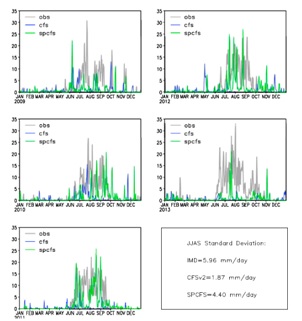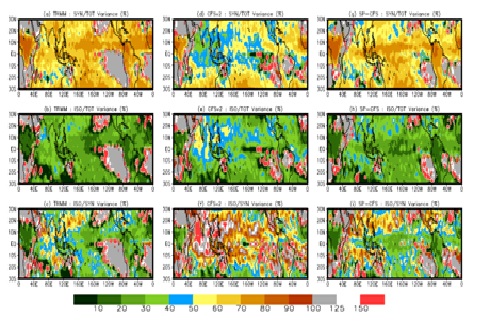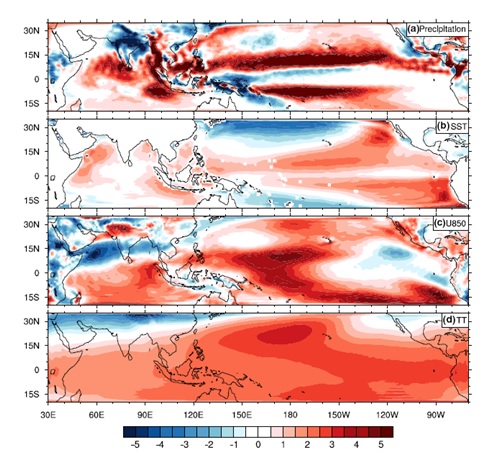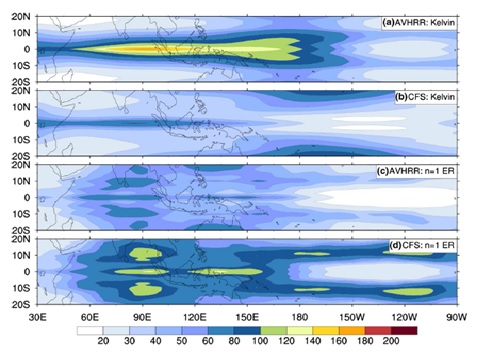About Us
The major responsibility of the project is to conduct basic research to improve the physical processes which in turn would help improve the model forecast. This group mostly focus on short range (up to a week) forecast with high resolution model and also focus on the monsoon intraseasonal oscillations and associated weather regimes.
Six scientists (Dr.Medha Deshpande, Mr. Malay Ganai, Mr. Sahadat Sarkar, Ms. Shilpa Malviya, Ms. Snehlata Trikey,Mr. Tanmoy Goswami) two Associate members (Dr.Phani Murlai Krishna and Mr. M. Mahakur) and a Ph. D. student Mr. Kumar Roy, led by Dr. P. Mukhopadhyay comprise the group.
Project Details
The major achievements of the projects are mentioned below:
- For the first time a superparameterised-CFSv2 (SP-CFS) version has been developed and implemented in IITM. The default CFS systematic bias during Indian Summer Monsoon is found to be significantly improved.
- The parameterization of default CFSv2 has been thoroughly revised by incorporating a Revised Simplified Arakawa Schubert scheme, more realistic cloud process parameterization through microphysics scheme WSM6 and suitable modification in radiation. The revised CFS is found to produce significant improvement in systematic bias and hindcast skill
- A state-of-the-art short range ensemble forecast based on GFS (GEFS) with 20 ensemble members have been established. Realtime (experimental) ensemble forecasts have been issued to IMD since June 2016 (http://srf.tropmet.res.in/srf/)
- Under Niti Ayog programme, A very high resolution GFS (SL) T1534 (~13 km) deterministic short range forecast system has been established and realtime (experimental) forecast has been initiated since September 2016 (http://srf.tropmet.res.in/srf/files/archive_hires.php)
Products:
1. Short Range Ensemble forecast GFS (http://srf.tropmet.res.in/srf/)
2. Short Range Deterministic Forecast with High Res. 12km GFS (http://srf.tropmet.res.in/srf/files/archive_hires.php)
3. Model Development
- Superparameterized CFSv2 (SPCFS)
- A revised version of CFS with modified convective scheme, microphysics and radiation
- CFS with Stochastic Multicloud Model parameterization.
Important Results:
-
Simulation of the Indian summer monsoon in the Superparameterised Climate Forecast System Version 2: Preliminary results
An analysis of a 5-year (from 1 January 2009 to 31 December 2013) free run of the superparameterised (SP) Climate Forecast System (CFS) version 2 (CFSv2) (SP-CFS), implemented for the first time at a spectral triangular truncation at wavenumber 62 (T62) atmospheric horizontal resolution is presented. The SP-CFS simulations are evaluated against observations and traditional convection parameterised CFSv2 simulations at T62 resolution as well as at some higher resolutions. The metrics for evaluating the model performance are chosen in order to mainly address the improvement in systematic biases observed in the CFSv2 documented in earlier studies. While the primary focus of this work is on evaluating the improvement of the simulation of the Indian summer monsoon (ISM) by the SP-CFS model, some results are also presented within the context of the global climate. The SP-CFS significantly reduces the dry bias of precipitation over the Indian subcontinent (Fig. 2) and better captures the monsoon intraseasonal oscillation (MISO) modes. SP-CFS also improves the northward and eastward propagation of high- and low-frequency modes of ISM. Compared to CFSv2, the SPCFS model simulates improved convectively coupled equatorial waves; better temperature structures both spatially and vertically, leading to a significantly improved relative distribution of variance for the synoptic disturbances and low-frequency tropical intraseasonal oscillations (ISOs) (Fig. 3). This analysis of the development of SP-CFS is particularly important as it shows promise for improving the cloud process representation through an SP framework and is able to improve the mean as well as intraseasonal characteristics of CFSv2 within the context of the ISM. [Goswami B.B., Krishna R.P.M., Mukhopadhyay P., Khairoutdinov M., Goswami B.N., Simulation of the Indian summer monsoon in the Superparameterized Climate Forecast System Version 2: Preliminary results, Journal of Climate, 28, November 2015, DOI:10.1175/JCLI-D-14-00607.1, 8988-9012]
 |
 |
| Fig.2: Evolution of rainfall over central India (18°-28°N, 73°-82°E) for observations (IMD; gray line), CFSv2 (blue line), and SP-CFS (green line), for all 5-year (2009-13) of the simulated climate. |
Fig. 3: Ratios of synoptic-scale (2-10-day band passed) variance to total variance for (a) TRMM, (d) CFSv2, and (g) SP-CFS; ratio of ISO scale (10-90 day band passed) variance to total variance for (b) TRMM,(e)CFSv2, and (h) SP-CFS; and ratio of ISO-scale variance to synoptic scale variance for (c) TRMM, (f) CFSv2, and (i) SP-CFS. All of the variances are computed for JJAS daily rainfall anomalies (mmday-1). |
-
Diagnosis of boreal summer intraseasonal oscillation in high resolution (T382) NCEP climate forecast system
The ability of high resolution (T382) National Centers for Environmental Prediction coupled atmosphere-ocean climate forecast system version2 (CFS T382) in simulating the salient spatio-temporal characteristics of the boreal summer time mean climate and the intraseasonal variability is examined. The shortcomings of the model are identified based on the observation and compared with earlier reported biases of the coarser resolution of CFS (CFS T126). It is found that the CFS T382 reasonably mimics the observed features of basic state climate during boreal summer. But some prominent biases are noted in simulating the precipitation, tropospheric temperature (TT) and sea surface temperature (SST) over the global tropics (Fig. 4). It is interesting to note that while CFS T126 shows colder SST and tropospheric temperature bias, CFS T382 shows a warmer SST and tropospheric temperature bias. However, the nature of rainfall bias remains similar with dry bias over Indian land mass and wet bias over Indian Ocean and tropical pacific region (Fig. 5). Although CFS T382 primarily reproduces the observed distribution of the intraseasonal variability over the Indian summer monsoon region, some difficulty remains in simulating the boreal summer intraseasonal oscillation (BSISO) characteristics. The simulated eastward propagation of BSISO decays rapidly across the Maritime Continent, while the northward propagation appears to be slightly slower than observation. However, the northward propagating BSISO convection propagates smoothly from the equatorial region to the northern latitudes with observed magnitude. Moreover, the observed northwest-southeast tilted rain band is not well reproduced in CFS T382. The warm mean SST bias and inadequate simulation of high frequency modes appear to be responsible for the weak simulation of eastward propagating BSISO. Further analysis of the convectively coupled equatorial waves (CCEWs) indicates that model overestimates the gravest equatorial Rossby waves and underestimates the Kelvin and mixed Rossby-gravity waves. Based on analysis of CCEWs, the study further explains the possible reasons behind the realistic simulation of northward propagating BSISO in CFS T382, even though the model shows substantial biases in simulating mean state and other BSISO modes. [Abhik S., Mukhopadhyay P., Krishna R.P.M., Salunke K.D., Dhakate A.R., Suryachandra A. Rao, Diagnosis of boreal summer intraseasonal oscillation in high resolution NCEP climate forecast system, Climate Dynamics, 46, May 2016, DOI:10.1007/s00382-015-2769-9, 3287-3303]
 |
 |
| Fig. 4: Seasonal mean bias in (a) precipitation (mm day−1), (b) SST (°C), (c) zonal wind at 850 hPa (m s−1) and (d) tropospheric temperature (TT, K) relative to TRMM, TMI and CFSR. |
Fig. 5: Distribution of boreal summer time OLR variance (W2m−4) of (a), (b) Kelvin and (c), (d) n = 1 ER for AVHRR and CFS T382 respectively. |
Project Highlight
- State-of-the art development of physical parameterization in CFSv2
- Establishment of short range ensemble forecast system based on GFS (GEFS)
- Establishment of deterministic global ~13 km high resolution GFS weather forecast system
- CFS with revised Cloud and Convection
CFS with revised Cloud and Convection
CFSv2 grid scale cloud microphysics has been revised by using a prognostic scheme for six class hydrometeors (WSM6). The revised CFS (CFS-CR) with modified sub-grid scale convection (Revised SAS), modified cloud microphysics (WSM6) is found to simulate a much realistic mean global and monsoon climate. Further it also shows promising improvement in capturing the convective and non-convective rainfall (Fig. 3) association with Boreal summer Intraseasonal Oscillation.

Fig. Convective and Non-Convective (stratiform) rain averaged over 40-120oE, 15oS-30oN:
Ctl: default CFST126; CFSCR: Revised Convective parameterization, WSM6 as
microphysics and SAM in the radiation.
Team
Project: Monsoon Mission
Project Directors: Dr. Suryachandra Rao, Scientist-G
Deputy Project Director: -
Sub-project: Parameterization of Physical Processes and Analyses















